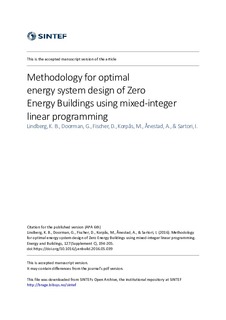| dc.contributor.author | Lindberg, Karen Byskov | |
| dc.contributor.author | Doorman, Gerard L. | |
| dc.contributor.author | Fischer, David | |
| dc.contributor.author | Korpås, Magnus | |
| dc.contributor.author | Ånestad, Astrid | |
| dc.contributor.author | Sartori, Igor | |
| dc.date.accessioned | 2017-11-06T11:25:44Z | |
| dc.date.available | 2017-11-06T11:25:44Z | |
| dc.date.created | 2016-07-20T10:41:57Z | |
| dc.date.issued | 2016 | |
| dc.identifier.citation | Energy and Buildings. 2016, 127 194-205. | nb_NO |
| dc.identifier.issn | 0378-7788 | |
| dc.identifier.uri | http://hdl.handle.net/11250/2464202 | |
| dc.description.abstract | According to EU’s Energy Performance of Buildings Directive (EPBD), all new buildings shall be nearly Zero Energy Buildings (ZEB) from 2018/2020. How the ZEB requirement is defined has large implications for the choice of energy technology when considering both cost and environmental issues. This paper presents a methodology for determining ZEB buildings’ cost optimal energy system design seen from the building owner’s perspective. The added value of this work is the inclusion of peak load tariffs and feed-in-tariffs, the facilitation of load shifting by use of a thermal storage, along with the integrated optimisation of the investment and operation of the energy technologies. The model allows for detailed understanding of the hourly operation of the building, and how the ZEB interacts with the electricity grid through the characteristics of its net electric load profile. The modelling framework can be adapted to fit individual countries' ZEB definitions. The findings are important for policy makers as they identify how subsidies and EPBD’s regulations influence the preferred energy technology choice, which subsequently determines its grid interaction. A case study of a Norwegian school building shows that the heat technology is altered from HP to bio boiler when the ZEB requirement is applied. | nb_NO |
| dc.description.sponsorship | Acknowledgments. This work has been supported by the Research Council of Norway and several partners through the Research Centre on Zero Emission Buildings (ZEB) and the Research Centre for Sustainable Energy Studies (CenSES). The authors also acknowledge the support from the Norwegian Water Resources and Energy Directorate (NVE) in Oslo, Norway, and Fraunhofer Institute for Solar Energy System (ISE) in Freiburg, Germany. | nb_NO |
| dc.language.iso | eng | nb_NO |
| dc.publisher | Elsevier B.V. | nb_NO |
| dc.rights | Attribution-NonCommercial-NoDerivatives 4.0 Internasjonal | * |
| dc.rights.uri | http://creativecommons.org/licenses/by-nc-nd/4.0/deed.no | * |
| dc.subject | Load profiles | nb_NO |
| dc.subject | Grid interaction | nb_NO |
| dc.subject | Self-consumption | nb_NO |
| dc.subject | Demand side management; DSM | nb_NO |
| dc.subject | Storage | nb_NO |
| dc.subject | Feed-in tariff; FiT | nb_NO |
| dc.subject | Photovoltaic; PV | nb_NO |
| dc.subject | Solar therminal | nb_NO |
| dc.subject | Mixed-integer linear programming; MILP | nb_NO |
| dc.subject | Cost-optimality | nb_NO |
| dc.subject | Zero energy buildings; ZEB | nb_NO |
| dc.subject | Weighting factors | nb_NO |
| dc.title | Methodology for optimal energy system design of Zero Energy Buildings using mixed-integer linear programming | nb_NO |
| dc.type | Journal article | nb_NO |
| dc.type | Peer reviewed | nb_NO |
| dc.description.version | publishedVersion | nb_NO |
| dc.rights.holder | © 2016 Elsevier B.V. All rights reserved. This is the authors' accepted and refereed manuscript to the article, post-print. Released with a Creative Commons Attribution Non-Commercial No Derivatives License. The final publication is available at https://doi.org/10.1016/j.enbuild.2016.05.039 | nb_NO |
| dc.subject.nsi | VDP::Technology: 500 | nb_NO |
| dc.source.pagenumber | 194-205 | nb_NO |
| dc.source.volume | 127 | nb_NO |
| dc.source.journal | Energy and Buildings | nb_NO |
| dc.identifier.doi | 10.1016/j.enbuild.2016.05.039 | |
| dc.identifier.cristin | 1368705 | |
| dc.relation.project | Norges forskningsråd: 193830 | nb_NO |
| dc.relation.project | Norges forskningsråd: 209697 | nb_NO |
| cristin.unitcode | 7401,30,20,0 | |
| cristin.unitname | Bygninger og installasjoner | |
| cristin.ispublished | true | |
| cristin.fulltext | original | |
| cristin.qualitycode | 2 | |

